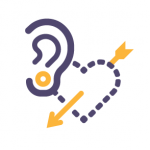4.5 Types of Nonverbal Communication
Now that you have learned about the general principles that apply to nonverbal communication, here are eight types of nonverbal communication to further understand this challenging aspect of communication:
- Space
- Time
- Eye Contact
- Body movements
- Touch
- Paralanguage
- Personal Style
 Space
Space
When we discuss space in a nonverbal context we are referring to the space between people, proxemics, as well as the space between objects and people.
Space is often associated with social rank and is an important part of business communication. Who gets the corner office? Why is the head of the table important and who gets to sit there?
Territory is related to control. As a way of establishing control over your own room, maybe you painted it your favourite colour, or put up posters that represent your interests or things you consider unique about yourself. Families or households often mark their space by putting up fences or walls around their houses. This sense of a right to control your space is implicit in territory. Territory means the space you claim as your own, are responsible for, or are willing to defend.
People from diverse cultures may have different normative space expectations. If you are from a large urban area, having people stand close to you may be normal, however a stranger coming to sit beside you on an empty bus may make you feel very uncomfortable. If you are from a rural area or a culture where people expect more space, someone may be standing “too close” for comfort, and not know it. How much space should you leave between yourself and a person you are conversing with when you first meet them? How close can you stand to a colleague before one or both of you feels uncomfortable?
Among most humans there is a basic need for personal space, but the normative expectations for space vary greatly by culture. You may perceive that in your home people sleep one to each bed, but in many cultures, people sleep two or more to a bed and it is considered normal. If you were to share that bed, you might feel uncomfortable, while someone raised with group sleeping norms might feel uncomfortable sleeping alone. From where you stand in an aerobics class in relation to others, to where you place your book bag in class, your personal expectations of space are often at variance with others.
Watch the following 3 minute video from CBS with special correspondent Taryn Winter Brill about personal space:
Video: Personal Space: How Close is Too Close? by CBS [2:55] Transcript available
 Time
Time
In chapter 3 we looked at chronemics in terms of cultural views of time, but chronemics considers the impact of time on communication as a whole, including non-verbal communication. Being late for an appointment may be considered rude by those in monochronic cultures, whereas those in polychronic cultures will have a much more fluid sense of time, and would expect you to be a half an hour late – in fact showing up earlier may present a problem because your host will not be ready. What message are you sending when you are late? Are you showing a lack of respect? Some people, and the communities and cultures they represent, are very time-oriented and expect strict punctuality; they may be offended and unwilling to wait if you are late. This sense of time can also be related to status. If your boss is 20 minutes late for a meeting the team will wait patiently, however the same patience will not be expected of your boss if you or a colleague are running late.
When thinking of time and nonverbal communication, we are not always referring to the time of day – it could be the time of year (you may offer your neighbour a quick wave when outside in the winter because it’s too cold to stand outside and exchange pleasantries), it could also be a time of life (young children have a very different perception of time than adults, and cannot be expected to wait as patiently as an adult), or a time in history (certain gestures in the Middle Ages would not be understood or accepted in the same way they would be in the 21st century).
Time is a relevant factor of the communication process in your speech. How slowly or quickly do you speak? Which tempo expresses enthusiasm and excitement as compared to a lack of engagement? When you give a presentation, does your audience have to wait for you to start or remain seated when you go 15 minutes overtime? The best way to show your audience respect is to honour the time expectation associated with your speech. Always try to stop speaking before the audience stops listening; if the audience perceives that you have “gone over time,” they will be less willing to listen. This in turn will have a negative impact on your ability to communicate your message.

Eye Contact
What is your impression of someone who won’t look you in the eye? Eye contact, or oculesics, plays a significant role in nonverbal communication and can have a big impact on our perception of another person. Are they shy? Nervous? Do they just lack confidence? Or are they untrustworthy? An interviewee, customer, or friend who avoids your glance may do so for a variety of reasons.
If we think of the sayings, “eyes are the window to the soul”, or, “if looks could kill”, they remind us of the range of emotions one can express through their eyes.
 Body Movements
Body Movements
The study of body movements, called kinesics, is key to understanding nonverbal communication.
Body movements in the form of facial expressions, hand gestures, and other forms of body language such as posture can complement the verbal message by reinforcing the main idea – or do the exact opposite. For example, as a server in a restaurant you ask patrons if they enjoyed their meal, and those at the table say, “Yes!”, smile broadly, and give you the “thumbs up” sign, you would be confident they were happy with their food. The patrons’ verbal and nonverbal messages reinforced each other. However, if the patrons frown slightly and offer a quiet “yah” with a slightly bowed head, you may determine that the meal did not meet their expectations. When a person’s verbal and non-verbal messages agree we trust the accuracy of the message more.
Body movements can also regulate conversations. Nodding your head to indicate that you are listening may encourage them to continue a difficult conversation. Holding your hand up, palm out, may signal them to stop and provide a pause where you can start to answer; it may also invite an angry response as your partner feels you are shutting them down.
Body movements can substitute for or replace verbal messages. For example, if a customer makes a face of frustration while trying to “tap” their credit card, they may need assistance. If they push away from the counter and separate themselves physically from interacting with the system, they may be extremely frustrated. Learning to gauge feelings and their intensity as expressed nonverbally takes time and patience, and can vary from culture to culture, but your attention to them will improve your ability to communicate and facilitate positive interactions.
 Touch
Touch
Haptics refers to communication by touch. What are you communicating when you touch someone on the arm? Are you showing care, affection, or trying to get them to listen to you? How will your touch be interpreted? Much depends on the individual’s cultural background and the setting. In social or business settings, physical touch may be completely unacceptable, especially between members of the opposite sex or between someone in authority and their junior.
Consider a handshake and the message you are sending by extending your hand and how firmly you grasp the hand of another. If you are giving a business presentation, you may interact with people by shaking hands and making casual conversation. This interaction can help establish trust before you deliver your pitch.
Watch the following short video that demonstrates the importance of handshakes. Bad Business Handshakes:
Video: The Top 10 Bad Business Handshakes by BusinessGovAu [3:00] Transcript available

Paralanguage
Paralanguage is also known as vocalics, and is the exception to the definition of nonverbal communication. You may recall that nonverbal communication was defined as “not involving words” but paralanguage is a unique form of nonverbal communication that exists when we are speaking, using words, or making sounds. Paralanguage involves tone, pitch and other nonverbal aspects of speech that influence meaning, including how loudly or softly you are speaking, intensity, pauses, and even silence. It can also refer to a sound such as a grunt, a sigh, or a snort of disbelief or disgust.
Perhaps you’ve heard of a pregnant pause, a silence between verbal messages that is full of meaning. The meaning itself may be hard to understand or decipher, but it is there nonetheless. For example, your coworker Jan comes back from a sales meeting speechless. You may ask if the meeting went all right. “Well, ahh…” may be the only response you get. The pause speaks volumes. Something happened, though you may not know what. Silence or vocal pauses can communicate hesitation, indicate the need to gather thought, or serve as a sign of respect. Sometimes we learn just as much, or even more, from what a person does not say, as from what they do say.
Watch the following 1 minute video. It’s Not What You Say, It’s How You Say It:
Video: Paralanguage – It’s Not WHAT You Say But HOW You Say It by Janet Harllee [1:18] Transcript available

Personal Style
Personal style covers a variety of things such as body decoration, hairstyles and clothing. Artifacts are forms of decorative ornamentation that are chosen to represent self-concept. They can include rings and tattoos, but may also include brand names and logos. From clothes to cars, watches, briefcases, purses, and even eyeglasses, what we choose to surround ourselves with communicates something about our sense of self. Artifacts may project gender, role or position, class or status, personality, and group membership or affiliation. Think of a uniform and what that may portray – a soldier, private school student, hockey player, nurse, lifeguard or a police officer – what are the nonverbal messages their attire sends? Paying attention to an individual’s artifacts can give you a sense of the self they want to communicate, and may allow you to more accurately adapt your message to meet their needs or situation.
Do you cover your tattoos when you are at work? Do you know someone who does? Or perhaps you know someone who has a tattoo and does not need to cover it up on their job? Expectations vary a great deal, and body art or tattoos may still be controversial in the workplace. In your line of work, a tattoo might be an important visual aid, or it might detract from your effectiveness as a business communicator. Body piercings may express individuality, but you need to consider how they will be interpreted by employers and customers.
You didn’t choose your genes, your eye colour, the natural colour of your hair, or your height, but people spend millions every year trying to change their physical characteristics. You can get coloured contacts, dye your hair, workout or have plastic surgery. If you are shorter than you’d like to be, you can buy shoes to raise your stature a couple of inches; no matter how much you stoop to appear shorter, however, you won’t change your height until time and age gradually take their toll. If you are tall, you might find the correct shoe size, pant length, or even the length of mattress a challenge, but there may also be rewards when it comes to how people perceive you. Regardless of your eye or hair colour, or even how tall you are, being comfortable with yourself is an important part of your presentation. Act naturally and consider aspects of your presentation you can control in order to maximize a positive image for the audience.
In this 1 minute, 24 second video, Adoni Irani, from the University of Toronto, shares the story behind his tattoos:
Video: Inked@UTSC: Adoni Irani explains his tattoos by University of Toronto Scarborough [1:24] Transcript available
In the same way that there are cultural contexts and expectations for nonverbal behaviour, public speaking also happens within different contexts. In North America, eye contact with the audience is expected. Big movements and gestures are not generally expected and can be distracting, however, they can also help you stand out and make a point. The speaker occupies a space on the “stage,” even if it’s in front of the class. When you occupy that space, the audience will expect you to behave in certain ways. If you talk to the screen behind you while displaying a PowerPoint presentation, the audience may perceive that you are not paying attention to them. Speakers are expected to pay attention to, and interact with, the audience, even if the feedback is primarily nonverbal or the presentation is made online. Your movements should coordinate with the tone, rhythm, and content of your speech. Pacing back and forth, keeping your hands in your pockets, or crossing your arms may communicate nervousness, or even defensiveness, and detract from your message.
To summarize, nonverbal communication can be categorized into seven types: space, time, eye contact, body movements, touch, paralanguage, and personal style.
“24. Types of Nonverbal Communication” from Communication for Business Professionals by eCampusOntario is licensed under a Creative Commons Attribution-NonCommercial-ShareAlike 4.0 International License.

